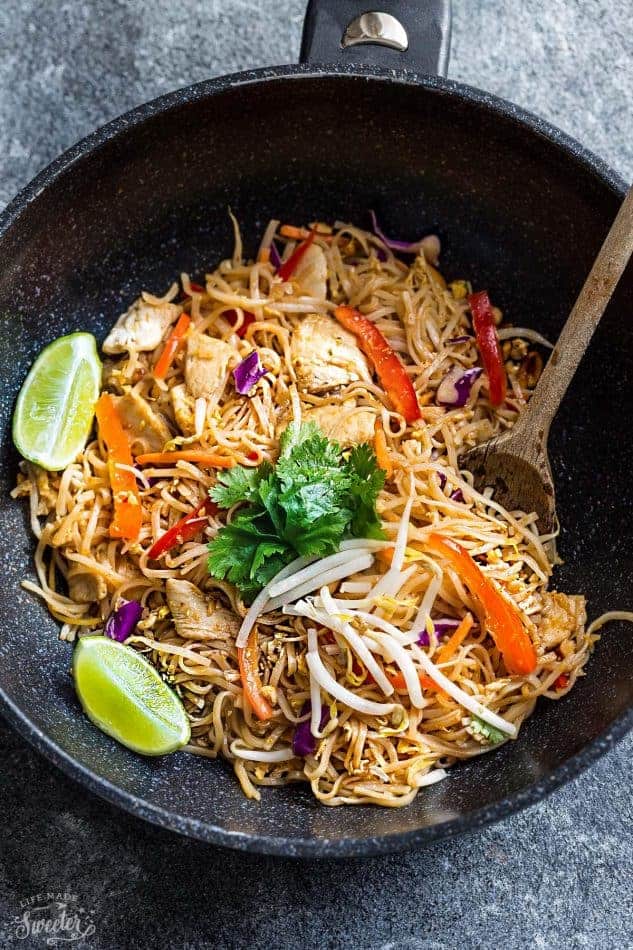This Pad Thai recipe is easy to make in under 30 minutes and full of authentic Thai flavors. Our healthy homemade Pad Thai is made in one pot and full of the traditional sweet, sour, spicy and savory flavors that you love from your favorite takeout restaurant. Includes options for grain-free, paleo, Whole30 and low carb.

Pin for later AND follow my Recipes Board on Pinterest for more easy dinner recipes!
Updated October 2020
Traditional Pad Thai Recipe
This delicious and easy Pad Thai recipe is one of our favorite takeout dishes to make at home. We have family back in Bangkok and used to visit there often. I fell completely head over heels in love, especially for the food. Their signature flavors made up of sweet, sour, spicy and savory are serious the best!
I spent a big chunk of my visits in the kitchen just following my aunts along and helping them out with meals whenever they let me. Of course, Chicken Pad Thai was on my list of things we had to perfect and my family says it’s just as delicious as their favorite Thai restaurant.
And if you’re looking for more healthy pad thai recipes, I also have Vegan Pad Thai, Keto Pad Thai with zucchini noodles or this Healthy Pad Thai made with sweet potato noodles.
What is Pad Thai?
Traditional Pad Thai is a stir-fry noodle dish made with a combination of rice noodles, scrambled egg, bean sprouts and either chicken, shrimp or tofu coated with a sweet and spicy sauce. It has to be the most popular dish that everyone thinks of when it comes to Thai food. But in Thailand, this stir fry noodle dish is simply a common street dish you can find just about everywhere.
Why you’ll love this easy pad thai recipe
- The best part about making your own healthy pad thai noodles at home is that you can skip the takeout and dinner can be on the table in as little as 25 minutes. Or less if you have everything prepped ahead of time!
- Much quicker, healthier and better than takeout! Plus, it reheats beautifully so it makes delicious leftovers for lunch the next day.
- We love that this stir-fry recipe can be made gluten-free, Whole30, with paleo options.
- Super easy to customize using your favorite protein and vegetables. Not a fan of chicken? Leave it out for Shrimp Pad Thai or leave the protein and eggs out completely for Vegan Pad Thai

Ingredients in Pad Thai
Authentic pad thai noodle recipes typically call for tamarind paste, fish sauce and brown sugar. Since we are trying to make our pad thai recipe healthier, we are also going to offer options to make them grain-free, paleo or Whole30 compliant:
For the pad thai noodles
- Dried uncooked flat rice noodles – for grain-free diets this can be swapped Shirataki/ Konjac noodles. These noodles from Miracle Noodle are what we like to use. Spiralized vegetable noodles work, too, like cooked spaghetti squash, zucchini noodles or sweet potato noodles
- Oil for cooking – we like avocado oil
- Boneless Skinless Chicken breast, sliced thinly – you can also sub with peeled medium shrimp or leave out for vegetarian pad thai
- Aromatics: Garlic cloves, freshly grated ginger and shallot
- Vegetables:
- Grated carrots
- Red bell peppers and green bell peppers for color and crunch
- Egg – lightly beaten
- Lime Wedge
- Salt and black pepper

For the authentic pad thai sauce
You can usually find these ingredients at your local Asian shop or in the International section of your grocery store
- Tamarind Concentrate – be sure NOT tamarind paste which is thicker (HIGHLY recommended but if you can’t find it, sub 1 1/2 Tablespoons peanut butter + 1/4 cup fresh lime juice)
- Thai red chili sauce – Sambal Oelek or sub with compliant Sriracha sauce or red chili sauce for Whole30
- Red Boat Fish sauce – highly recommended for that authentic pad thai flavor
- Oyster sauce – adds that extra umami flavor – you can sub with vegan oyster sauce or Primal Kitchen’s No Soy Teriyaki Sauce for paleo / Whole30
- Coconut sugar– low glycemic paleo sweetener that mimics the taste of brown sugar and adds a nice sweetness to this Thai recipe. If you want to make this sauce keto, then sub with granulated monk fruit sweetener or use homemade date paste or apple juice for a Whole30 pad thai sauce
- Concentrated tomato paste , optional for additional color and to mimic the North American version as the authentic Thai version does not use this
Garnish and Toppings:
- Chopped fresh cilantro
- Bean sprouts
- Green onions
- Chopped peanuts
- Garlic chives
- Additional lime wedges
What noodles are best for the best Pad Thai
- You want to use dried rice noodles which are typically found in your local Asian market or large grocery stores in the International / Ethnic section. You can also find them online. We like to use a medium thickness like these Gluten Free Pad Thai Noodles. Sometimes they are called Banh Pho (5mm thick) or Rice Noodle Sticks.
- For grain-free diets swap with Shirataki/ Konjac noodles. These noodles from Miracle Noodle are what we like to use. Spiralized vegetable noodles work, too, like cooked spaghetti squash, zucchini noodles or sweet potato noodles are great for Whole30 Pad Thai.
How to make Pad Thai Noodles
Making these easy stir fried Thai noodles at home couldn’t be easier. Be sure to follow the step-by-step instructions, photos or watch the video below.
- PREPARE THE NOODLES: Prepare the rice noodles according to package instructions. (I usually just soak mine for 6-7 minutes in boiling water). They should be soft but not mushy – see my photo below for how they should look at this point. Drain and immediately rinse under cool water and set aside in a colander.
- WHISK INGREDIENTS: While the noodles are cooking, whisk together the sauce ingredients in a medium bowl. If you prefer a sweeter pad thai – add additional sugar. For a spicier version, add additional chili paste
- COOK THE CHICKEN: Heat the oil in a large wok or non-stick skillet over high heat. Add the chicken and cook until browned and mostly cooked through (about 3-4 minutes).
- SAUTE THE VEGETABLES: Stir in the ginger, garlic, and shallots and cook for 30 seconds, until fragrant. Add the carrots and bell pepper and cook for 1-2 minutes, until tender crisp. Push all the ingredients over to one side of the pan. Pour the beaten egg and scramble directly in the skillet.
- TOSS IN NOODLES: Add noodles and pour the sauce over top. Toss with tongs to evenly coat noodles. Remove from heat (do not overcook the noodles or they will get soggy)
- SEASON TO TASTE AND SERVE: Squeeze in juice from the lime wedge and adjust seasoning by adding some salt, black pepper, fish sauce, (tomato paste – if using) and chili paste. Serve hot on a large platter with garnishes by sprinkling on cilantro, bean sprouts, peanuts and green onions and additional lime wedges on the side..
Tips for the best pad thai noodles
- Prep all your ingredients: Have all your vegetables, sauce and noodles prepped and ready by your stove.
- Wok: Use a cast-iron wok for that traditional smoky flavor
- Noodles: The key is to prepare your rice noodles until they are just al dente so they don’t turn mushy when you fry them. I like to soak mine in hot water for about 7-10 minutes, then rinse with cold water.
- Fish sauce is HIGHLY recommended for that unmistakeable Thai flavor. For a VEGAN & GLUTEN version, check out FYSH SAUCE as a great substitute. But if you must skip it, use additional soy sauce or coconut aminos
- Double the sauce: if you like your noodles saucier – double the sauce and add desired amount to noodles. Save the leftovers for a stir-fry or even a salad.

Variatons
- Swap out the chicken for your favorite protein – We use chicken here, but you can also add shrimp for a Chicken and Shrimp Pad Thai noodles or even beef or pork. Leave out the meat and add tofu for a meatless version.
- Vegetables – we like to use a colorful assortment of veggies. Not a fan of bell peppers? No problem – leave them out or swap them out with whatever vegetables you like or have on hand. You can also leave out the protein completely for vegetarian.
- For extra saucy noodles, feel free to double the savory sauce recipe
- Instead of rice noodles – use spiralized veggies like zoodles or sweet potato noodles
- If you don’t have access to tamarind concentrate (more watery – NOT tamarind paste which is thicker) – use 1 tablespoon peanut butter and 3 tablespoons lime juice or rice vinegar instead.
- Use gluten free tamari or coconut aminos for Whole30 or Paleo Pad Thai

Make ahead, reheating and storage instructions
The best part about making this easy pad thai recipe at home is that it works perfect for meal-prep especially if you make a double batch.
- To make ahead: Cook your noodles the day before. Mince or chop the garlic, ginger and wash and cut the vegetables the day before. Store in the fridge in separate containers or resealable bags.
- Wondering how long does Pad Thai last in the fridge? You can store this delicious dish in the refrigerator for up to 5 days. Be sure to allow the noodles to cool down then transfer to airtight containers,
- How to reheat pad thai: When you’re ready to enjoy your leftover pad thai noodles, it’s best to either sauté it in a wok or pan on medium low heat over the stove or in a microwave-safe bowl in the microwave.

Meal prepping
We love to make this pad thai recipe for weekly meal preps! Chicken pad thai a one-pan dinner recipe that is easy to make in huge batches that will last the entire week and perfect for packing in school or work lunches.
Let your noodles cool then pack into meal prep containers. We like these glass containers for home and these lunch containers for school and work. Pack with your favorite side – Jasmine rice, brown rice, cauliflower rice or spiralized vegetables – zoodles.

More delicious Thai recipes you’ll love:
Spicy Thai Chili Chicken Wings
Slow Cooker Thai Peanut Chicken

This Pad Thai recipe is easy to make in under 30 minutes and full of authentic Thai flavors. Our healthy homemade Pad Thai is made in one pot and full of the traditional sweet, sour, spicy and savory flavors that you love from your favorite takeout restaurant. Includes options for grain-free, paleo, Whole30 and low carb.
- 3-1/2 Tablespoons tamarind concentrate more watery - NOT tamarind paste which is thicker (HIGHLY recommended but if you can't find it, sub with 1 1/2 tablespoons peanut butter + 1/4 cup fresh lime juice)
- 2 teaspoons Thai red chili sauce Sambal Oelek or Sriracha to taste - (I like mine spicy so I usually add about 3/4 tablespoons) - sub with compliant hot sauce for paleo / Whole30
- 4 Tablespoons red boat fish sauce highly recommended** or sub with Vegan FYSH SAUCE
- 3 Tablespoons oyster sauce recommended - use vegan oyster sauce or Primal Kitchen's No Soy Teriyaki Sauce for paleo
- 4 Tablespoons coconut sugar or brown sugar (if not paleo) - leave out for Whole30
- 1.5 teaspoons concentrated tomato paste , optional for additional color and to mimic the North American version as the authentic Thai version does not use this
- 8 ounces dried uncooked rice noodles , sub with Miracle Noodle, Shirataki or Konjac noodles for grain-free or spiralized vegetables for Whole30
- 2 Tablespoons cooking oil , avocado oil for a healthier version
- 6 oz chicken breast , sliced thinly (can also sub with shrimp or leave out for vegetarian)
- 2 garlic cloves , minced
- 1 teaspoon freshly grated ginger
- 1 shallot , diced
- 1/3 cup grated carrots
- 1 red or green bell pepper , thinly sliced (I used a combo of both for extra color)
- 1 large egg , lightly beaten (leave out for vegan)
- 1 lime wedge
- salt, black pepper and more fish sauce to taste
- Chopped fresh cilantro , bean sprouts, chopped roasted peanuts, green onions and additional lime wedges
- Takeout style Lunch containers
- Glass Lunch Boxes
- Prepare the rice noodles according to package instructions. (I usually just soak mine for 6-7 minutes in boiling water). They should be soft but not mushy - see my photo above for how it should look at this point. Drain and immediately rinse under cool water and set aside in a colander.

- While the noodles are cooking, whisk together the sauce ingredients in a medium bowl. If you prefer a sweeter pad thai - add additional sugar. For a spicier version, add additional chili paste.

- Heat the oil in a large wok or non-stick skillet over high heat. Add the chicken and cook until browned and mostly cooked through (about 3-4 minutes). Stir in the ginger, garlic, and shallots and cook for 30 seconds, until fragrant. Add the carrots and bell pepper and cook for 1-2 minutes, until tender crisp. Push all the ingredients over to one side of the pan. Pour the beaten egg and scramble directly in the skillet.

Add noodles and pour the sauce over top. Toss with tongs to evenly coat noodles. Remove from heat (do not overcook the noodles or they will get soggy).

- Squeeze in juice from the lime wedge and adjust seasoning by adding some salt, black pepper, fish sauce, (tomato paste - if using) and chili paste.
- Serve hot on a large platter with garnishes by sprinkling on cilantro, bean sprouts, peanuts and green onions and additional lime wedges on the side.

- For meal prep, divide the noodles evenly into lunch boxes and store in refrigerator until ready to reheat.

Recipe Video
If you like more sauce, double the amount of sauce and add desired amount and save the rest in an airtight container for next time or use it up in a stir-fry or salad.
**Fish sauce is available in the Asian food section of most grocery stores or you can purchase it online. They also make a VEGAN version as well as a gluten free version. I HIGHLY recommend using any one of these, as it adds important saltiness and irreplaceable Thai flavor to the dish. If you must make a substitution, use additional low-sodium soy sauce.
Store leftovers in an airtight container in the refrigerator for 3-4 days. Reheat gently in the microwave with a splash of water or chicken broth to keep the noodles from drying out



















 Did you try this recipe?
Did you try this recipe?






Pia -
We love it
Bob -
Mama mia
Cheri -
Oh yea!!
Janice -
Delicious
Zelda -
Yum